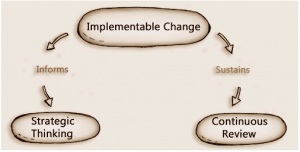
Why Continuous Review Creates Sustainable Change
Picture an oil tanker: clunky and precarious, it moves steadfastly towards its destination, but is prone to a dangerous oil spill that may cause massive destruction. Many organisations function like an oil tanker, and thus sacrifice learning in the name of efficiency – but continuous review is a necessary process that can help keep oil spills at bay.
Most organisations carry out review from the top down, and apart from their standard operating procedures. Review is normally driven by a study of external outlook, forecast, or previous organisational performance. Yet this type of review does not necessarily facilitate learning, which hinders the process in the long run. Organisations need to be under continuous review, which makes it more adaptable and safeguarded against external threats.
It may be difficult to see the importance of review when things are working fine on the surface, but taking the time to look closely can illuminate small cracks before they turn into big ones. Toyota learned the importance of continuous review after serious corporate failings forced the multinational auto company to recall more than 9 million vehicles worldwide. Its leaders thereafter confessed that “their quest to become the world’s largest automobile producer had compromised their devotion to learning.” [1] It is also essential to note that the reason for failure was due to a top-down goal that blocked the natural processes. The review process should be bottom up, in order to be efficient.
Types of continuous review
There are several ways you can implement continuous review in your organisation. These sessions should occur in conjunction with the standard yearly review. They include:
- Daily review: These sessions should happen in an open meeting space and last no more than fifteen minutes. They should address the problems of the day, and allow for no more than four questions focused around issue management and assurance. While it might be difficult to gather everyone for a fifteen-minute quick review, this can be turned into a coffee break where people share unexpected events that recently happened such as “A procedure was missed yesterday”. In this case, the moderator should be able to keep the discussion open and on going.
- Weekly review: Weekly review gives an overview of a specific activity. They revolve around essential questions, such as what is working well, how issues can be fixed, and what lessons can be learned.
- Monthly review: These sessions should set out the organisation’s direction and should last no more than two hours. These meetings are critical, as they outline any changes that will be made going forward. It is easy to fall into the routine for monthly reviews and do the same presentation over and over again. In such cases, reflection from the employees is crucial as to learn about the areas that need improvement and what can be done about them.
- Quarterly review: These reviews centre around questions concerning investment. Here, the organisation decides where special emphasis needs to be made, and check up on long-term initiatives.
Subsidiarity for success
For governments, “subsidiarity” means performing tasks at the lowest, most local and practical level. This concept can be applied to organisations as well: how can we ensure an initiative is being performed at all relevant levels? Continuous review helps ensure that subsidiaries are performed for an organisation’s overall success.
As this infographic demonstrates, continuous review creates a virtuous circle that sustains implementable change, and vice versa.
Take Boeing Commercial Airplanes (BCA) for example. Their weekly executive reviews were invaluable due to a lack of input from the employees, even though they had plans ready for the next ten years. So in 2001, they decided to appoint a Leadership Team that was responsible to hold weekly meetings to uncover procedural problems in the company that could have long term impacts. “Once a specific course of action is agreed upon and approved by BCA’s leadership team, the long-range business plan is updated at the next weekly review to reflect the projected change in financial performance”[2]
When a company is facing a transformational change, the need for continuous review is even more pronounced. More information about continuous review in the context of transformational change can be found in The Art of Transformational Change by Ketan Varia.
Oil tankers barge through the sea to their destination, with little regard for the journey. Don’t let your organisation run like an oil tanker – continuously self-assess, and learn from your mistakes and opportunities, instead of risking an oil spill.
Ketan Varia, with editorial support from Jessica Prupas and Burcu Atay
[1] Gino and Stats. ‘Why Organizations Don’t Learn.’ Harvard Business Review, 2015. Web. Accessed Feb 2016.
[2] Mankins and Steele. “Stop Making Plans; Start Making Decisions.” Harvard Business Review. 2006. Web. 28 Feb. 2016.

